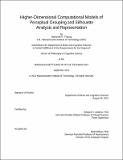| dc.contributor.advisor | Edward H. Adelson. | en_US |
| dc.contributor.author | Twarog, Nathaniel R | en_US |
| dc.contributor.other | Massachusetts Institute of Technology. Dept. of Brain and Cognitive Sciences. | en_US |
| dc.date.accessioned | 2013-03-13T15:55:22Z | |
| dc.date.available | 2013-03-13T15:55:22Z | |
| dc.date.copyright | 2012 | en_US |
| dc.date.issued | 2012 | en_US |
| dc.identifier.uri | http://hdl.handle.net/1721.1/77844 | |
| dc.description | Thesis (Ph. D.)--Massachusetts Institute of Technology, Dept. of Brain and Cognitive Sciences, 2012. | en_US |
| dc.description | This electronic version was submitted by the student author. The certified thesis is available in the Institute Archives and Special Collections. | en_US |
| dc.description | Cataloged from student-submitted PDF version of thesis. | en_US |
| dc.description | Includes bibliographical references (p. 100-105). | en_US |
| dc.description.abstract | In the following thesis, I describe the investigation of two problems related to the organization and structural analysis of visual information: perceptual grouping and silhouette analysis and representation. For the problem of perceptual grouping, an intuitive model framework was developed which operates on raw images and locates relevant groupings utilizing a higher dimensional space that contains not only the two spatial dimensions of the image but one or more dimension corresponding to relevant image features such as luminance, hue, or orientation. A psychophysical experiment was run to measure how human visual observers perform perceptual grouping across a variety of spatial scales and luminance differences. These results were compared with the predictions of our grouping model, and the model was able to capture much of the grouping behavior of the human subjects. A second experiment was run in which the perception of groups was disrupted by the presence of noise or shifts in brightness. Though the experiments showed only small effects resulting from these disruptions on the behavior of human subjects, the model was still able to successfully capture much of the image-to-image variability. For the question of silhouette representation and analysis, I suggest that human silhouette representation may be inextricably tied to 3D interpretation of 2D shapes. To support this, I propose a novel algorithm for 2D silhouette inflation called Puffball, which closely matches human intuition for a variety of simple shapes and can be run on almost any input. Using this algorithm, a new model of human part segmentation was derived using 2D-to-3D inflation; this model was evaluated against human-generated part segmentations and two competing part segmentation algorithms. Across a variety of different analyses, Puffball part segmentation performed as well or better than its competitors, suggesting a potential role for 2D-to-3D inflation in the segmentation of silhouette parts. Finally, I suggest several avenues of research which may further illuminate the role of inflation in the human representation and analysis of 2D and 3D shape. | en_US |
| dc.description.statementofresponsibility | by Nathaniel R. Twarog. | en_US |
| dc.format.extent | 108 p. | en_US |
| dc.language.iso | eng | en_US |
| dc.publisher | Massachusetts Institute of Technology | en_US |
| dc.rights | M.I.T. theses are protected by
copyright. They may be viewed from this source for any purpose, but
reproduction or distribution in any format is prohibited without written
permission. See provided URL for inquiries about permission. | en_US |
| dc.rights.uri | http://dspace.mit.edu/handle/1721.1/7582 | en_US |
| dc.subject | Brain and Cognitive Sciences. | en_US |
| dc.title | Higher-dimensional computational models of perceptual grouping and silhouette analysis and representation | en_US |
| dc.type | Thesis | en_US |
| dc.description.degree | Ph.D. | en_US |
| dc.contributor.department | Massachusetts Institute of Technology. Department of Brain and Cognitive Sciences | |
| dc.identifier.oclc | 827831511 | en_US |
